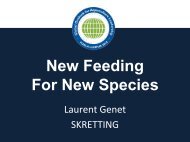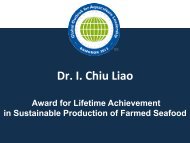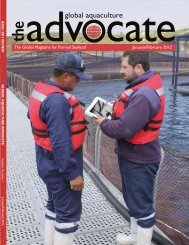May/June 2010 - Global Aquaculture Alliance
May/June 2010 - Global Aquaculture Alliance
May/June 2010 - Global Aquaculture Alliance
You also want an ePaper? Increase the reach of your titles
YUMPU automatically turns print PDFs into web optimized ePapers that Google loves.
Community • Environment<br />
• Food Safety • Traceability<br />
Wholesome<br />
Seafood.<br />
Responsibly<br />
Produced.<br />
Achieve greater market<br />
and consumer<br />
acceptance through<br />
Best <strong>Aquaculture</strong> Practice<br />
certification.<br />
Over 200 aquaculture facilities<br />
around the world are now BAPcertified.<br />
Join these farms, hatcheries<br />
and processing plants<br />
in demonstrating your commitment<br />
to responsible aquaculture –<br />
and receive recognition for your<br />
effort through the BAP retail mark.<br />
BAP certification<br />
is now available for:<br />
• Shrimp<br />
• Tilapia<br />
• Channel Catfish Farms<br />
• Processing Plants<br />
• Shrimp Hatcheries<br />
Coming Soon:<br />
Pangasius Farms, Feed Mills<br />
®<br />
Keep aquaculture<br />
sustainable –<br />
now and into<br />
the future.<br />
GO BAP!<br />
Developed by<br />
<strong>Global</strong> <strong>Aquaculture</strong> <strong>Alliance</strong><br />
www.gaalliance.org<br />
+1-314-293-5500<br />
and isoleucine. The biofloc protein level can<br />
be increased to about 65%, and the quality<br />
of the essential amino acids profile in biofloc<br />
can be further optimized by changing<br />
the effluent used, bioreactor methodology<br />
and/or carbon source and level.<br />
Feeding Trials<br />
Two feeding trials were conducted to<br />
determine if biofloc can be used to<br />
replace fishmeal and/or soybean protein<br />
in shrimp diets. Each five-week trial was<br />
conducted in recirculating aquaculture<br />
systems with optimal water quality conditions<br />
for shrimp culture.<br />
The bioflocs were dried and incorporated<br />
into experimental diets formulated<br />
to be equivalent for crude protein (35%)<br />
and total fat (8%). The biofloc diets were<br />
compared against high-quality control<br />
diets by replacing fishmeal and/or soy<br />
Composition (% dry-matter basis)<br />
3.0<br />
2.5<br />
2.0<br />
1.5<br />
1.0<br />
0.5<br />
0<br />
Leucine<br />
Lysine<br />
Arginine<br />
Valine<br />
Isoleucine<br />
protein. In the first trial, only SBR bioflocs<br />
were tested. Both SBR and MBR<br />
bioflocs were used in the second trial at<br />
twice the inclusion rate of the first trial.<br />
The weight gain of shrimp in the trials is<br />
presented in Figure 2.<br />
Shrimp fed biofloc diets during the<br />
first trial outgrew shrimp given the control<br />
diet by an average of 49%. During<br />
the second trial, shrimp on biofloc diets<br />
outgrew the control shrimp by approximately<br />
10%.<br />
Regardless of the inclusion rate of<br />
total diet (0 to 30%), amount of fishmeal<br />
replaced (0 to 67%) or soy protein<br />
replaced (0 to 100%), shrimp fed biofloc<br />
diets grew slightly or significantly faster.<br />
These data suggested that bioflocs can be<br />
a suitable, if not superior, ingredient for<br />
shrimp feed.<br />
Phenylalanine<br />
Threonine<br />
Biofloc<br />
Typical Feed<br />
Methionine<br />
Histidine<br />
Tryptophan<br />
Figure 1. Essential amino acid profiles of a representative biofloc ingredient versus typical<br />
high-quality shrimp feed.<br />
Average weight Gain (g)<br />
9<br />
8<br />
7<br />
6<br />
5<br />
4<br />
3<br />
2<br />
1<br />
0<br />
Trial 1 Trial 2<br />
Control<br />
SBR 8%<br />
SBR 16%<br />
Control<br />
SBR 10%<br />
SBR 15%<br />
SBR 21%<br />
MBR 10%<br />
MBR 15%<br />
MBR 21%<br />
MBR 30%<br />
Figure 2. Weight gain of shrimp fed diets with bioflocs from a sequencing batch reactor<br />
(SBR) or membrane batch reactor (MBR) over five weeks.<br />
WE BRING THE SOURCE<br />
TO OUR CUSTOMERS<br />
BEST AQUACULTURE PRACTICES<br />
CERTIFIED<br />
Pescanova is committed to providing our clients the highest quality aquaculture products while<br />
ensuring social and environmental responsibility, food safety and traceability.<br />
• Best <strong>Aquaculture</strong> Practices & Traceability<br />
• ACC-Certified Production Centers<br />
• Vertically Integrated Production & Distribution<br />
If you would like to learn more about Pescanova USA representing your products, contact us today 800-990-6292 x 7020<br />
or via e-mail- sales@pescanovausa.com. Visit us online at pescanovausa.com<br />
76 <strong>May</strong>/<strong>June</strong> <strong>2010</strong> global aquaculture advocate global aquaculture advocate <strong>May</strong>/<strong>June</strong> <strong>2010</strong> 77<br />
<br />
GUYANA PINKS





